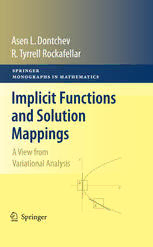
Implicit Functions and Solution Mappings: A View from Variational Analysis PDF
Preview Implicit Functions and Solution Mappings: A View from Variational Analysis
S M M pringer onographs in athematics EditorialBoard S.Axler K.A.Ribet Forfurthervolumes: www.springer.com/series/3733 Asen L. Dontchev (cid:129) R. Tyrrell Rockafellar Implicit Functions and Solution Mappings A View from Variational Analysis With 12 Illustrations ABC AsenL.Dontchev R.TyrrellRockafellar MathematicalReviews UniversityofWashington 416FourthStreet DepartmentofMathematics AnnArbor,MI48107-8604 POBox354350 USA Seattle,WA98195-4350 ald@ams.org USA rtr@math.washington.edu ISSN1439-7382 e-ISSN ISBN978-0-387-87820-1 e-ISBN978-0-387-87821-8 DOI10.1007/978-0-387-87821-8 SpringerDordrechtHeidelbergLondonNewYork LibraryofCongressControlNumber:2009926485 MathematicsSubjectClassification(2000):26B10,47J07,58C15,49J53,49K40,90C31,93C70 (cid:2)cSpringerScience+BusinessMedia,LLC2009 Allrightsreserved.Thisworkmaynotbetranslatedorcopiedinwholeorinpartwithoutthewritten permission of the publisher (Springer Science+Business Media, LLC, 233 Spring Street, New York, NY10013, USA),except forbrief excerpts inconnection with reviews orscholarly analysis. Usein connectionwithanyformofinformationstorageandretrieval,electronicadaptation,computersoftware, orbysimilarordissimilarmethodologynowknownorhereafterdevelopedisforbidden. Theuseinthispublicationoftradenames,trademarks,servicemarks,andsimilarterms,eveniftheyare notidentifiedassuch,isnottobetakenasanexpressionofopinionastowhetherornottheyaresubject toproprietaryrights. Printedonacid-freepaper SpringerispartofSpringerScience+BusinessMedia(www.springer.com) Preface Settingupequationsandsolvingthemhaslongbeenso importantthat,inpopular imagination, it has virtually come to describe what mathematical analysis and its applicationsare all about. A centralissue in the subjectis whetherthe solution to anequationinvolvingparametersmaybeviewedasafunctionofthoseparameters, andifso,whatpropertiesthatfunctionmighthave.Thisisaddressedbytheclassical theoryofimplicitfunctions,whichbeganwithsinglerealvariablesandprogressed through multiple variables to equations in infinite dimensions, such as equations associatedwithintegralanddifferentialoperators. A major aim of the book is to lay out that celebrated theory in a broader way thanusual, bringingto lightmanyof its lesser knownvariants,forinstance where standardassumptionsof differentiabilityare relaxed.However,anothermajor aim is to explain how the same constellation of ideas, when articulated in a suitably expanded framework, can deal successfully with many other problems than just solvingequations. Thesedays,formsofmodelinghaveevolvedbeyondequations,interms,forex- ample, of problemsof minimizing or maximizing functions subject to constraints whichmayincludesystemsofinequalities.Thequestioncomesupofwhetherthe solution to such a problem may be expressed as a function of the problem’s pa- rameters, but differentiability no longer reigns. A function implicitly obtainable this manner may only have one-sided derivatives of some sort, or merely exhibit Lipschitz continuity or something weaker. Mathematical models resting on equa- tionsare replacedby “variationalinequality”models,whichare furthersubsumed by“generalizedequation”models. Thekeyconceptforworkingatthislevelofgenerality,butwithadvantageseven in the context of equations, is that of the set-valued solution mapping which as- signstoeachinstanceoftheparameterelementinthemodelallthecorresponding solutions,if any.Thecentralquestioniswhethera solutionmappingcanbe local- ized graphicallyin order to achievesingle-valuednessand in that sense producea function,thedesiredimplicitfunction. Inmodernvariationalanalysis,set-valuedmappingsareanacceptedworkhorse in problem formulation and analysis, and many tools have been developed for v vi Preface handlingthem.Therearehelpfulextensionsofcontinuity,differentiability,andre- gularityofseveraltypes,togetherwithpowerfulresultsabouthowtheycanbeap- plied. A corresponding further aim of this book is to bring such ideas to wider attentionbydemonstratingtheiraptnessforthefundamentaltopicathand. Inlinewithclassicalthemes,weconcentrateprimarilyonlocalpropertiesofso- lutionmappingsthatcanbecapturedmetrically,ratherthanonresultsderivedfrom topologicalconsiderationsorinvolvingexoticspaces.Inparticular,weonlybriefly discusstheNash–Moserinversefunctiontheorem.Wekeeptofinitedimensionsin Chapters 1 to 4, but in Chapters 5 and 6 provide bridges to infinite dimensions. Global implicit functiontheorems, including the classical Hadamard theorem,are notdiscussedinthebook. InChapter1weconsidertheimplicitfunctionparadigmintheclassicalcaseof thesolutionmappingassociatedwithaparameterizedequation.Wegivetwoproofs oftheclassicalinversefunctiontheoremandthenderivetwoequivalentformsofit: the implicitfunctiontheoremand the correctionfunctiontheorem.Then we grad- ually relax the differentiability assumption in various ways and even completely exitfromit,relyinginsteadontheLipschitzcontinuity.We also discusssituations in which an implicit function fails to exist as a graphical localization of the so- lution mapping, but there nevertheless exists a function with desirable properties servinglocallyasaselectionoftheset-valuedsolutionmapping.Thischapterdoes notdemandofthereadermorethancalculusandsomelinearalgebra,anditcould thereforebeusedbybothteachersandstudentsinanalysiscourses. Motivated by optimization problems and models of competitive equilibrium, Chapter 2 movesinto wider territory.The questionsare essentially the same as in the first chapter, namely, when a solution mapping can be localized to a function withsomecontinuityproperties.Butitisnolongeranequationthatisbeingsolved. Insteaditisaconditioncalledageneralizedequationwhichcapturesamorecom- plicateddependenceandcovers,asaspecialcase,variationalinequalityconditions formulatedintermsoftheset-valuednormalconemappingassociatedwithacon- vex set. Although our prime focus here is variational models, the presentation is self-contained and again could be handled by students and others without special background.Itprovidesanintroductiontoasubjectofgreatapplicabilitywhichis hardlyknowntothemathematicalcommunityfamiliarwithclassicalimplicitfunc- tions,perhapsbecauseofinadequateaccessibility. In Chapter 3 we departfrom insisting on localizationsthat yield implicitfunc- tionsandapproachsolutionmappingsfromtheangleofa“varyingset.”Weidentify continuitypropertieswhichsupporttheparadigmoftheimplicitfunctiontheoremin aset-valuedsense.Thischaptermaybereadindependentlyfromthefirsttwo.Chap- ter4continuestoviewsolutionmappingsfromthisanglebutinvestigatessubstitutes forclassicaldifferentiability.Byutilizingconceptsofgeneralizedderivatives,weare abletogetimplicitmappingtheoremsthatreachfarbeyondtheclassicalscope. Chapter5 takesa differentdirection.ItpresentsextensionsoftheBanachopen mappingtheoremwhichareshowntofitinfinite-dimensionallyintotheparadigmof thetheorydevelopedfinite-dimensionallyinChapter3.Somebackgroundinbasic functionalanalysisisrequired.Chapter6goesfurtherdownthatroadandillustrates Preface vii howsome ofthe implicitfunction/mappingtheoremsfromearlierin the bookcan beusedinthestudyofproblemsinnumericalanalysis. This bookis targetedata broadaudienceof researchers,teachersand graduate students,alongwithpractitionersinmathematicalsciences,engineering,economics andbeyond.Insummary,itconcernsoneofthechieftopicsinallofanalysis,his- toricallyandnow,anaidnotonlyintheoreticaldevelopmentsbutalsoinmethods forsolvingspecificproblems.Itcrossesthroughseveraldisciplinessuchasrealand functionalanalysis,variationalanalysis,optimization,andnumericalanalysis,and canbeusedinpartasagraduatetextaswellasareference.Itstartswithelemen- tary results and with each chapter, step by step, opens wider horizonsby increas- ing the complexity of the problems and concepts that generate implicit function phenomena. Manyexercisesareincluded,mostofthemsuppliedwithdetailedguides.These exercises complement and enrich the main results. The facts they encompass are sometimesinvokedinthesubsequentsections. Eachchapterendswithashortcommentarywhichindicatessourcesintheliter- aturefortheresultspresented(butisnotasurveyofalltherelatedliterature).The commentariesto someofthe chaptersadditionallyprovidehistoricaloverviewsof pastdevelopments. WhidbeyIsland,Washington AsenL.Dontchev August,2008 R.TyrrellRockafellar Acknowledgements SpecialthanksareowedtoourreadersMariusDurea,ShuLu,YoshiyukiSekiguchi and Hristo Sendov, who gave us valuable feedback on the entire manuscript, and to Francisco J. Arago´n Artacho, who besides reviewing most of the book helpedusmasterfullywithallthe figures.Duringvariousstagesofthewritingwe also benefited from discussions with Aris Daniilidis, Darinka Dentcheva, He´le`ne Frankowska,MichelGeoffroy,AlexanderIoffe,StephenRobinson,VladimirVeliov, andConstantinZa˘linescu.WearealsogratefultoMaryAnglinforherhelpwiththe finalcopy-editingofthebook. Theauthors ix
